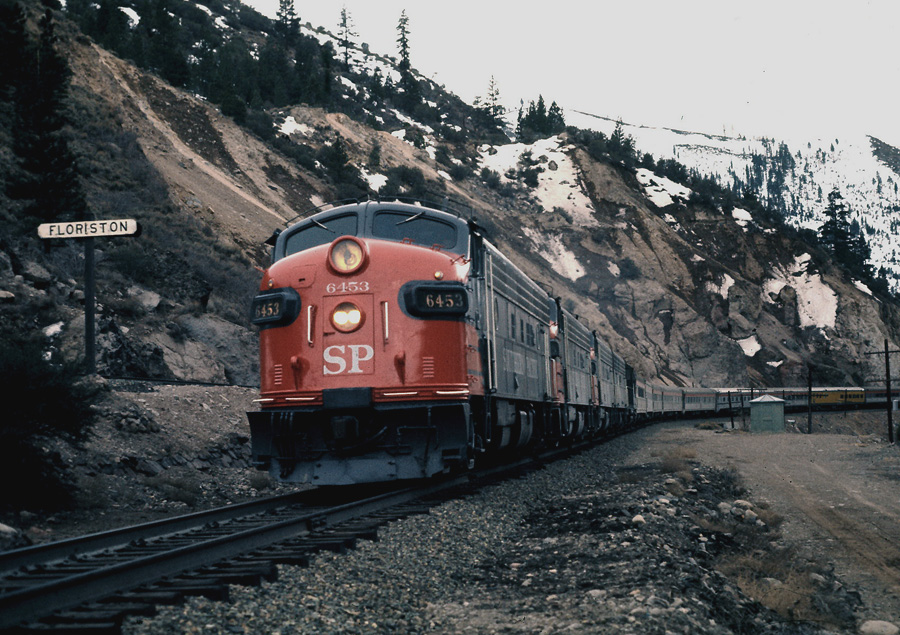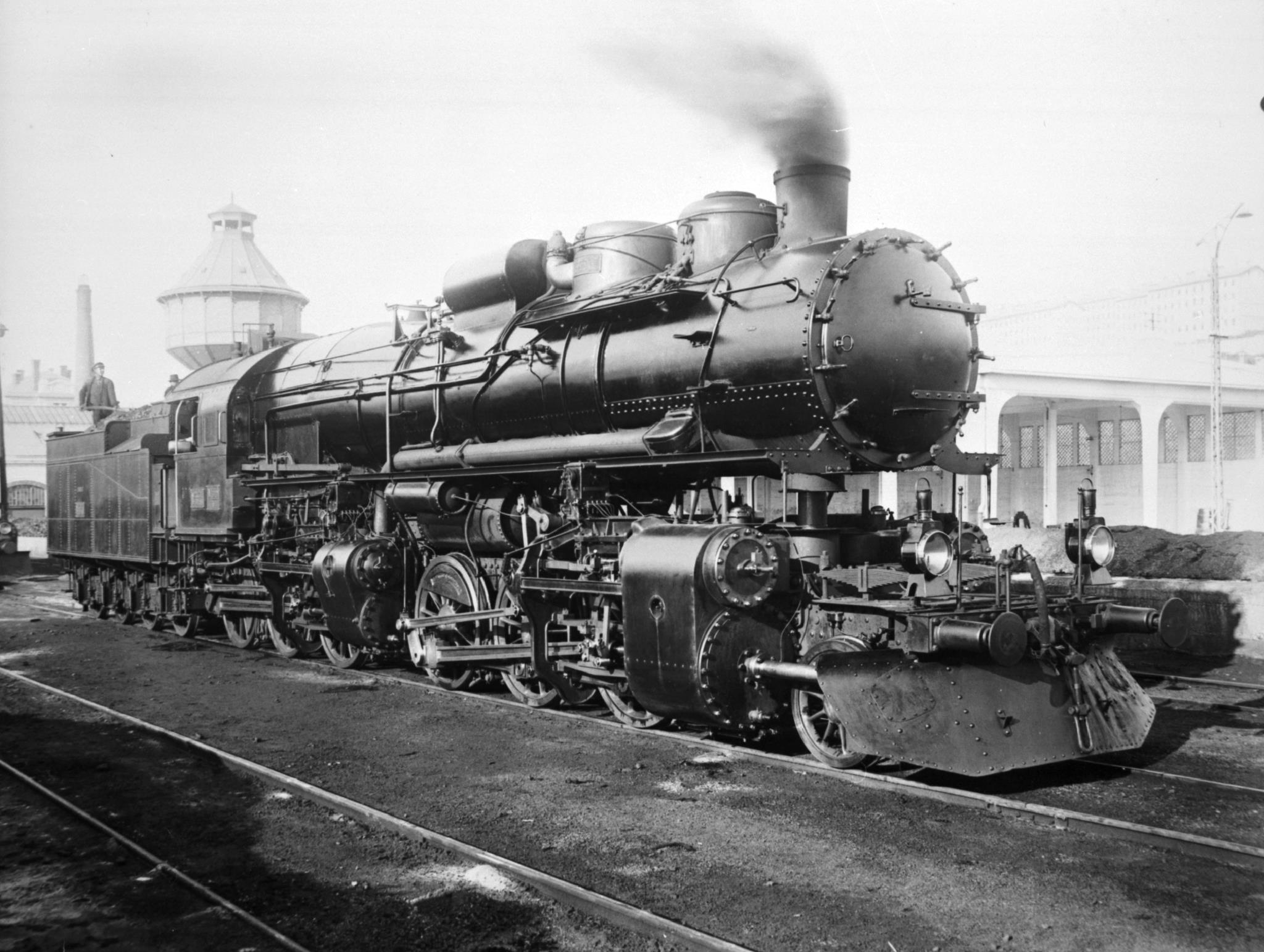|
Southern Pacific Class MC-2
Southern Pacific Railroad's MC-2 class of steam locomotives was the first class to be ordered by and built for Southern Pacific (SP) as cab forward locomotives. They were built in 1909 following the design of SP's MC-1 class built earlier that year. The success of this locomotive model led to the design and introduction of the AC class of 4-8-8-2 cab forward locomotives in the 1930s and 1940s. In order to get the fuel oil from the tender to the opposite end of the locomotive where the firebox sat, SP had to pressurize the oil in the tender. of air pressure was sufficient to get the oil to the fire. The two MC-1 locomotives built in May 1909 were rebuilt in 1923 as MC-2 class with uniform cylinders measuring diameter × stroke; these rebuilt locomotives weighed , like the as-built MC-2 class, but with on the drivers. Most of the rest of the MC-2 class were "simpled" to the same size cylinders by 1931. Except for numbers 4011 and 4013 which were both scrapped by 1936, all o ... [...More Info...] [...Related Items...] OR: [Wikipedia] [Google] [Baidu] |
Southern Pacific Railroad
The Southern Pacific (or Espee from the railroad initials- SP) was an American Railroad classes#Class I, Class I Rail transport, railroad network that existed from 1865 to 1996 and operated largely in the Western United States. The system was operated by various companies under the names Southern Pacific Railroad, Southern Pacific Company and Southern Pacific Transportation Company. The original Southern Pacific began in 1865 as a land holding company. The last incarnation of the Southern Pacific, the Southern Pacific Transportation Company, was founded in 1969 and assumed control of the Southern Pacific system. The Southern Pacific Transportation Company was acquired in 1996 by the Union Pacific Corporation and merged with their Union Pacific Railroad. The Southern Pacific legacy founded hospitals in San Francisco, Tucson, Arizona, Tucson, and Houston. In the 1970s, it also founded a telecommunications network with a state-of-the-art microwave and fiber optic backbone. This ... [...More Info...] [...Related Items...] OR: [Wikipedia] [Google] [Baidu] |
Tractive Effort
As used in mechanical engineering, the term tractive force can either refer to the total traction a vehicle exerts on a surface, or the amount of the total traction that is parallel to the direction of motion. In railway engineering, the term tractive effort is often used synonymously with tractive force to describe the pulling or pushing capability of a locomotive. In automotive engineering, the terms are distinctive: tractive effort is generally higher than tractive force by the amount of rolling resistance present, and both terms are higher than the amount of drawbar pull by the total resistance present (including air resistance and grade). The published tractive force value for any vehicle may be theoretical—that is, calculated from known or implied mechanical properties—or obtained via testing under controlled conditions. The discussion herein covers the term's usage in mechanical applications in which the final stage of the power transmission system is on ... [...More Info...] [...Related Items...] OR: [Wikipedia] [Google] [Baidu] |
Railway Locomotives Introduced In 1909
Rail transport (also known as train transport) is a means of transport that transfers passengers and goods on wheeled vehicles running on rails, which are incorporated in tracks. In contrast to road transport, where the vehicles run on a prepared flat surface, rail vehicles ( rolling stock) are directionally guided by the tracks on which they run. Tracks usually consist of steel rails, installed on sleepers (ties) set in ballast, on which the rolling stock, usually fitted with metal wheels, moves. Other variations are also possible, such as "slab track", in which the rails are fastened to a concrete foundation resting on a prepared subsurface. Rolling stock in a rail transport system generally encounters lower frictional resistance than rubber-tyred road vehicles, so passenger and freight cars (carriages and wagons) can be coupled into longer trains. The operation is carried out by a railway company, providing transport between train stations or freight customer ... [...More Info...] [...Related Items...] OR: [Wikipedia] [Google] [Baidu] |
Steam Locomotives Of The United States
Steam is a substance containing water in the gas phase, and sometimes also an aerosol of liquid water droplets, or air. This may occur due to evaporation or due to boiling, where heat is applied until water reaches the enthalpy of vaporization. Steam that is saturated or superheated is invisible; however, "steam" often refers to wet steam, the visible mist or aerosol of water droplets formed as water vapor condenses. Water increases in volume by 1,700 times at standard temperature and pressure; this change in volume can be converted into mechanical work by steam engines such as reciprocating piston type engines and steam turbines, which are a sub-group of steam engines. Piston type steam engines played a central role in the Industrial Revolution and modern steam turbines are used to generate more than 80% of the world's electricity. If liquid water comes in contact with a very hot surface or depressurizes quickly below its vapor pressure, it can create a steam explosion. Ty ... [...More Info...] [...Related Items...] OR: [Wikipedia] [Google] [Baidu] |
Mallet Locomotives
The Mallet locomotive is a type of articulated steam railway locomotive, invented by the Swiss engineer Anatole Mallet (1837–1919). The front of the locomotive articulated on a bogie. The compound steam system fed steam at boiler pressure to high-pressure cylinders driving the rear set of driving wheels (rigidly connected to the boiler). The exhaust steam from these cylinders was fed into a low-pressure receiver and was then sent to low-pressure cylinders that powered the driving wheels on the swiveling bogie towards the front of locomotive. Compounding Steam under pressure is converted into mechanical energy more efficiently if it is used in a compound engine; in such an engine steam from a boiler is used in high-pressure (HP) cylinders and then under reduced pressure in a second set of cylinders. The lower-pressure steam occupies a larger volume and the low-pressure (LP) cylinders are larger than the high-pressure cylinders. A third stage (triple expansion) may be em ... [...More Info...] [...Related Items...] OR: [Wikipedia] [Google] [Baidu] |
Baldwin Locomotives
Baldwin is a Germanic name, composed of the elements ''bald'' "bold" and ''win'' "friend". People * Baldwin (name) Places Canada * Baldwin, York Regional Municipality, Ontario * Baldwin, Ontario, in Sudbury District * Baldwin's Mills, Quebec United States * Baldwin County, Alabama * Baldwin, Florida * Baldwin, Georgia * Baldwin County, Georgia * Baldwin, Illinois * Baldwin, Iowa * Baldwin, Louisiana * Baldwin, Maine * Baldwin, Maryland * Baldwin, Michigan * Baldwyn, Mississippi * Baldwin, Chemung County, New York * Baldwin, Nassau County, New York ** Baldwin (LIRR station) * Baldwin, North Dakota * Baldwin, Pennsylvania * Baldwin, Wisconsin * Baldwin (town), Wisconsin Other places * Baldwin Street Baldwin Street, in Dunedin, New Zealand is located in the residential suburb of North East Valley, northeast of Dunedin's central business district. ''Guinness World Records'' calls it the steepest street in the world, meaning no street gain ..., in Dune ... [...More Info...] [...Related Items...] OR: [Wikipedia] [Google] [Baidu] |
Southern Pacific Railroad Locomotives
Southern may refer to: Businesses * China Southern Airlines, airline based in Guangzhou, China * Southern Airways, defunct US airline * Southern Air, air cargo transportation company based in Norwalk, Connecticut, US * Southern Airways Express, Memphis-based passenger air transportation company, serving eight cities in the US * Southern Company, US electricity corporation * Southern Music (now Peermusic), US record label * Southern Railway (other), various railways * Southern Records, independent British record label * Southern Studios, recording studio in London, England * Southern Television, defunct UK television company * Southern (Govia Thameslink Railway), brand used for some train services in Southern England Media * ''Southern Daily'' or '' Nanfang Daily'', the official Communist Party newspaper based in Guangdong, China * '' Southern Weekly'', a newspaper in Guangzhou, China * Heart Sussex, a radio station in Sussex, England, previously known as "Southe ... [...More Info...] [...Related Items...] OR: [Wikipedia] [Google] [Baidu] |
World War II
World War II or the Second World War, often abbreviated as WWII or WW2, was a world war that lasted from 1939 to 1945. It involved the World War II by country, vast majority of the world's countries—including all of the great powers—forming two opposing military alliances: the Allies of World War II, Allies and the Axis powers. World War II was a total war that directly involved more than 100 million Military personnel, personnel from more than 30 countries. The major participants in the war threw their entire economic, industrial, and scientific capabilities behind the war effort, blurring the distinction between civilian and military resources. Air warfare of World War II, Aircraft played a major role in the conflict, enabling the strategic bombing of population centres and deploying the Atomic bombings of Hiroshima and Nagasaki, only two nuclear weapons ever used in war. World War II was by far the List of wars by death toll, deadliest conflict in hu ... [...More Info...] [...Related Items...] OR: [Wikipedia] [Google] [Baidu] |
Feedwater Heater
A feedwater heater is a power plant component used to pre-heat water delivered to a steam generating boiler. Preheating the feedwater reduces the irreversibilities involved in steam generation and therefore improves the thermodynamic efficiency of the system.Fundamentals of Steam Power by Kenneth Weston, This reduces plant operating costs and also helps to avoid to the boiler metal when the feedwater is introduced back into the steam cycle. In a steam power plant (usually modeled as a modified |
Southern Pacific Class AC-1
Southern Pacific Railroad's AC-1 class of cab forward steam locomotives consisted of locomotives rebuilt from MC-1 and MC-2 class locomotives that were originally built by Baldwin Locomotive Works The Baldwin Locomotive Works (BLW) was an American manufacturer of railroad locomotives from 1825 to 1951. Originally located in Philadelphia, it moved to nearby Eddystone, Pennsylvania, in the early 20th century. The company was for decades t ... in 1909.. The MC-2 class was the first class of locomotives built and delivered to SP as cab forward locomotives in late 1909. The AC-1 class was the first of the successful AC series of cab forward locomotives that numbered nearly 200 in total on the SP. Southern Pacific No. 4002 was rebuilt in June 1923 as a Cab Forward. Their rebuilds into class AC-1 was around June 1931. SP used the rebuilt locomotives through the traffic rush of World War II, then the SP removed them from the roster soon after the war. They were all retired from ac ... [...More Info...] [...Related Items...] OR: [Wikipedia] [Google] [Baidu] |
Baldwin Locomotive Works
The Baldwin Locomotive Works (BLW) was an American manufacturer of railroad locomotives from 1825 to 1951. Originally located in Philadelphia, it moved to nearby Eddystone, Pennsylvania, in the early 20th century. The company was for decades the world's largest producer of steam locomotives, but struggled to compete as demand switched to diesel locomotives. Baldwin produced the last of its 70,000-plus locomotives in 1951, before merging with the Lima-Hamilton Corporation on September 11, 1951, to form the Baldwin-Lima-Hamilton Corporation. The company has no relation to the E.M. Baldwin and Sons of New South Wales, Australia, a builder of small diesel locomotives for sugar cane railroads. History: 19th century Beginning The Baldwin Locomotive Works had a humble beginning. Matthias W. Baldwin, the founder, was a jeweler and whitesmith, who, in 1825, formed a partnership with machinist David H. Mason, and engaged in the manufacture of bookbinders' tools and cylinders fo ... [...More Info...] [...Related Items...] OR: [Wikipedia] [Google] [Baidu] |




